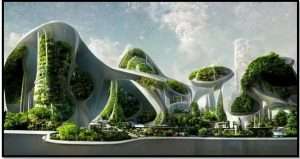Professor Dr. Riyadh Kadem Salman al-Jumaili
College of Education for Humanities / Department of Applied Geography

Introduction:
Among the most prominent modern trends in contemporary planning sciences is the tendency towards achieving the principle of sustainability in urban and urban plans for cities and towns alike in various parts of the world, especially in developed countries. Perhaps the pressing environmental and climatic problems and challenges are what determine the paths of future planning. Sustainability seeks to find appropriate urban means and alternatives that consider the principle of preserving the environment and natural resources and try to employ them to ensure their survival and continuity for the most extended possible period. Nature and its environmental conditions can also be active elements in urban planning processes, such as green architecture and environmentally friendly urban and environmental plans. In formulating this article, we will clarify the general objectives of sustainable planning and its most prominent means and challenges.
1- The concept of sustainable urban planning
The concept of (sustainability) has entered many sciences due to its great importance at the theory and application level. Planning sciences are one of the fastest in responding to this humanitarian principle. Sustainable planning has been circulating in urban planning literature since the beginning of the third millennium. It is intended to establish and achieve planning principles based on the principles of sustainability in response to the rapid population increase and the development of the size of urban population requirements, specifically within large cities, in a way that achieves an environmental-human balance between available resources and the turbulent population increase and preserves for future generations their right to planning, resources and wealth (1). The planner tries to formulate urban plans that integrate the environment and its requirements within the urban plans of cities, making it an essential principle of planning principles and its spatial requirements to prevent the exacerbation of pollution crises and the effects of climate change, which has become the most dangerous indicator in the lives of urban societies in particular.
2- Sustainable urban planning objectives
Sustainable planning aims to achieve several principles and establish them within urban plans for cities, the most important of which are:
– integrating environmental variables (local environment) within the rules and principles of urban planning.
– Finding a spatial balance in the city’s urban space that considers the city’s requirements for services and functions on the one hand and its environmental reality must be taken into account, and its character must be preserved without infringing on the available natural resources.
Another important principle of sustainable planning is the need for a fair planning vision in managing the city’s urban resources. This vision aims to create an integrated system of services that operates according to the principle of sustainability of urban resources, ensuring equal access for all residents.
– Finding a state of flexibility and rationality in urban planning, including linking planning objectives to urban, population and environmental changes.
Setting future forecasting of resources as a logical path is a crucial principle of sustainable planning. By building expected scenarios for changes and finding appropriate urban alternatives, we can ensure that the city is prepared for future challenges while maintaining its spatial and environmental requirements.
3-Pillars of sustainable urban planning
A- Creating an urban environment that is in harmony with contemporary technological development
Modern technology tools and means have imposed man developments at the level of space and its urban usage methods in technological ways that are extremely fast, possible and managed, which puts the city and its service institutions at stake in their ability to coexist with the new technical situation and what it leads to in terms of an advanced state of using software, technologies, information and sustainability, all of which are factors that put pressure on urban space and the requirements for its planning and organizing its resources. From this standpoint, sustainable planning is based in all its principles on creating an urban environment capable of interaction, flexibility, and tactics, finding alternatives with contemporary technical reality and managing its institutions and services with what contemporary technology can offer in terms of information and an advanced electronic environment that does not skip over the environmental and urban reality of the city. This is the complex debate that sustainable planning seeks to solve and develop advanced planning methods that serve the city and its urban environment to ensure that it keeps up with the contemporary civilizational bandwagon.
B- Harnessing available resources in planning elements
This principle is expressed by (the spatial integration of the plan), which is based on taking into account the natural resources and human expertise available in the spatial framework of the urban plan and absorbing and employing such available indicators in the stages of developing urban plans and ways to benefit from them in a way that achieves the optimal employment of these resources away from the principle of exploiting and depleting them for purely planning reasons and trying to establish the principle of humanity in planning and spatial and temporal justice for the population, resources and requirements.
C- Urban management based on the principle of possibility and adaptability
Sustainable planning seeks to produce urban management that is different from the classical model in the concept of urban management. Establishing the principle of ethics in the urban management of cities has become one of the most prominent features of sustainable urban planning and an attempt to develop the city’s capabilities to be a humane environment par excellence in which all social classes enjoy justice equality, equal opportunities and services before any other economic or profit calculation. Adaptation does not only mean managing the city in times of hardship and crisis, but it also means creating opportunities for development and the ability to balance and have high flexibility in designing and developing applicable and simulating alternatives that do not harm society’s urban and environmental system (2).
D- Establishing the principle of sustainability within the elements and requirements of planning.
One of the most prominent principles of sustainable planning is ensuring the establishment of the principle of (sustainability) in all stages of planning processes, starting from selecting and preparing urban spaces and determining the type of urban uses appropriate for each urban space. Choosing the appropriate spaces for each use, in addition to the necessity of preserving their environmental, human and civilizational capabilities, is what gives the characteristic of urban sustainability to the plan that is developed for this space and the methods of dealing with it with tools and means that respect the character of the place and preserve its privacy.
E- The Future of Sustainable Urban planning
Ensuring the achievement and consolidation of the principle of sustainability of urban and regional planning for cities in their cycle will provide more significant opportunities for producing numerous urban models based on diversity, development, and flexibility managed through contemporary technology and its various means. Today, we are witnessing the emergence of new concepts and descriptions of cities that we have not heard of before, all of which stem from the capabilities of sustainable urban planning. Technology cities, cities of the future, space cities, sustainable environmental cities and other specifications and concepts that are trying to find a way for themselves in future city plans. This is a foresight into the urban future of cities and their planning methods.
Reference:
(1)Vladimir Novotny, Jack Ahern, and Paul Brown(2010) ,, WATERCENTRIC SUSTAINABLE COMMUNITIES ,, Planning, Retrofitting, and Building the Next Urban Environment , Published by John Wiley & Sons, Inc., Hoboken, New Jersey ,USA, pp: 72. BDF. www.wiley.com.
(2)Robert Riddell, (2004) , Sustainable Urban Planning (( Tipping the Balance)) , First published 2004 by Blackwell Publishing Ltd Library of Congress Cataloging-in-Publication Data , PP:28 , http://www.blackwellpublishing.com .





























































